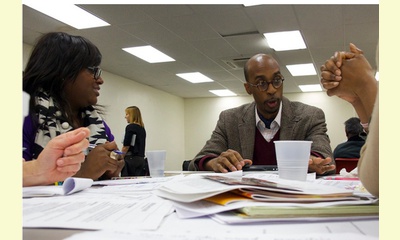|
|
New York City: Participatory Budgeting: Catch the Fever!
un article par Sondra Youdelman, City Limits
A public housing development in the South Bronx. A senior
center in East Harlem. A farmers market in Greenpoint. A
community organization office in Red Hook. A street corner in
Sunset Park's Chinatown. A public school in Kensington. A
church in The Rockaways. What do all these places have in
common? 
Residents of Flatbush [New York City] discuss projects during the first round of participatory budgeting, in 2011. Photo by: Colin Weatherby
click on photo to enlarge
They were all voting sites for Participatory Budgeting NYC
(PBNYC) back in April when nearly 17,000 residents from
across 10 NYC Council Districts came together to vote on how
to spend over $14 million in City funds.
PB is a powerful community decision-making process that was
sparked by the Workers Party in Porto Alegre, Brazil in 1989
and is now being utilized in over 1,500 cities around the
world.
Community Voices Heard (CVH) first heard about participatory
budgeting back in 2002 when a small delegation of members
attended the World Social Forum, an annual meeting of civil
society organizations bringing together non-governmental
organizations, advocacy campaigns, as well as formal and
informal social movements seeking international solidarity.
CVH members attended workshops about PB in Brazil and our
interest was sparked. We found it hard to believe that there
was a government that allowed the PEOPLE to decide how
public monies were spent, but we were impressed. It seemed
like the way it ought to be if transparency, engagement and
equity were to be at the core of government.
But, this was something of dreams, we thought; not a real
possibility for NYC.
And yet, in 2011, four daring City Council members—Melissa
Mark-Viverito, Brad Lander, Jumaane Williams, and Eric Ulrich
—decided to partner with CVH and The Participatory
Budgeting Project, along with an array of other community
partners, to initiate a pilot project in NYC. Now, only three
years later, 22 Council Members have taken up the challenge
—committing at least $25 Million to a public vote—and central
Council staff and resources now support the process.
PB "fever" has hit NYC and a new way of governing is now
being institutionalized.
Participatory Budgeting allows ordinary people to directly
decide how public monies are spent. Through a multi-month
engagement process, people come together to brainstorm
ideas, develop project proposals, interface with city agencies
to determine costs, present ideas back to their community,
and vote on projects that make it to the ballot.
With real money on the table and expanded rules about who
can vote, PB even inspires traditionally disenfranchised
populations to engage. In fact, expanding civic engagement
and developing new community leaders is one of the explicit
goals of the initiative, and empowerment and inclusion are
explicit principles.
(This article is continued in the discussionboard)
|








|
DISCUSSION
Il n'y pas encore de question liée à cet article.
* * * * *
Commentaire le plus récent:
(The following is continued from the main article listed above)
Research on the process carried out by the Community Development Project at the Urban Justice Center demonstrates that the diversity of NYC is being represented in the process and new people are getting engaged: two-thirds of PB voters were women; 60 percent identified as people of color; 49 percent had less than a college degree; nearly half have household incomes less than $50,000; 32 percent were born in another country; 22 percent of ballots were cast in a language other than English; almost 70 percent had never worked with others in their community to solve problems; and 22 percent of PB voters identified barriers that made them ineligible to vote in traditional elections.
We all live side by side in our communities, and all of voices should count. With young people ages 16 and up, undocumented immigrants, and the formerly incarcerated all able to vote in PB, the electorate is being expanded and new voices are being brought into the process of governing.
A fully inclusive and equitable process, however, takes work. If PBNYC is going to continue to hold true to our founding vision and principles, we need to constantly challenge ourselves and our government officials to do better. Energy and resources need to be dedicated to ensuring that the process is accessible for all New Yorkers. Extra efforts are needed to advance inclusivity. And new tools need to be created to make sure that resident committees are well equipped to evaluate projects through a lens of equity and prioritize those that meet the deepest needs.
There are plenty of challenges we've already met along the way—particularly given the limited resources on hand for implementation of the process—but the beauty of PB is that each year we can improve upon the process and make sure that everyone has a voice and agency in doing so. People not only have a vote, but can also contribute to making the process itself better if they're willing to pitch in and work towards it.
The expansion to 22 districts this week is monumental, but the possibilities shouldn't stop here. CVH has a long-term goal of seeing significantly more resources to be allocated through PB processes.
Imagine if all City Council Members allocated the majority of their discretionary funds through PB, as is done in Chicago. . ... continuation.

|
|









